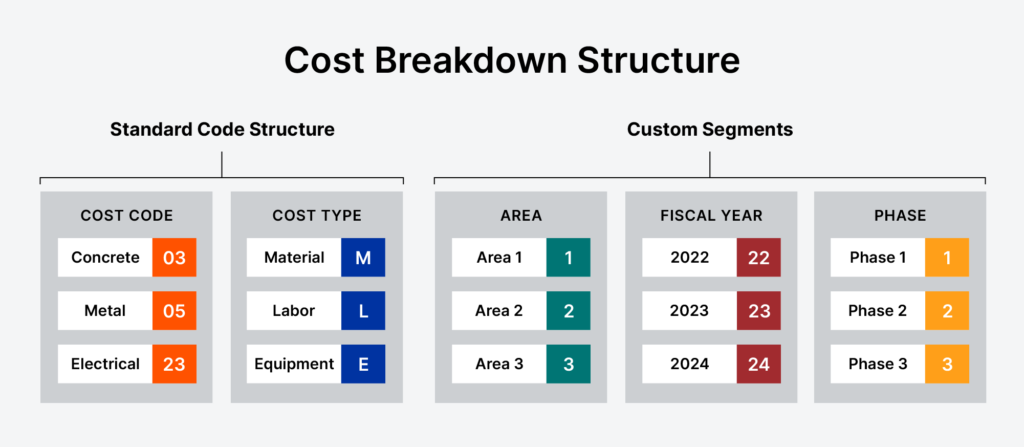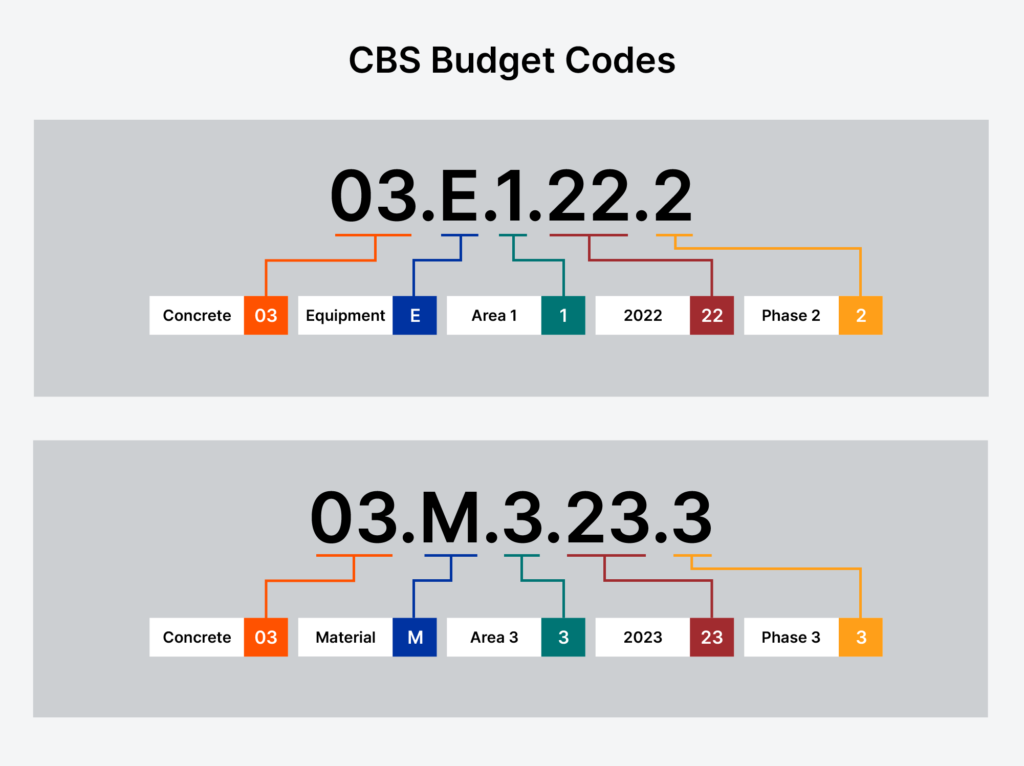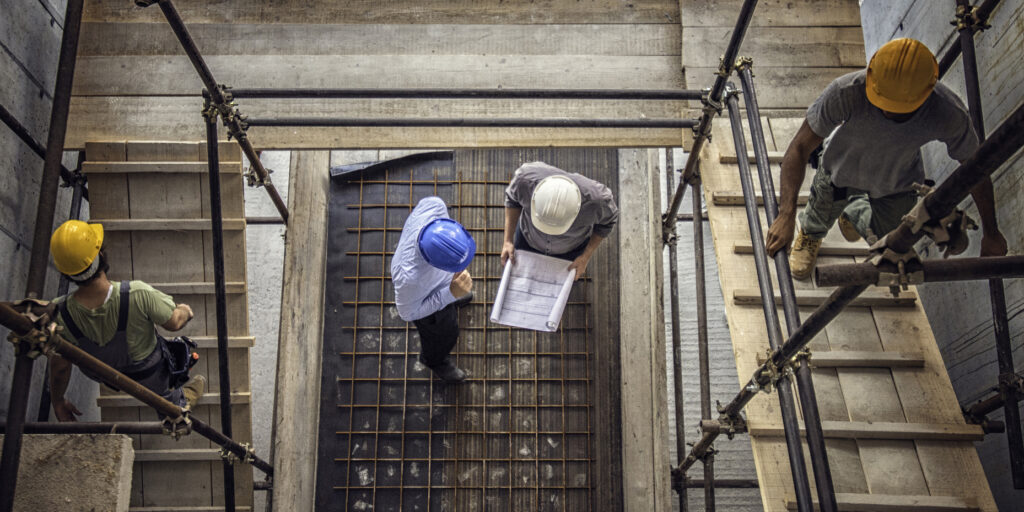— 8 min read
Cost Breakdown Structure: Enhancing Financial Clarity in Construction


Last Updated Aug 7, 2025

TJ Forbes
Senior Solutions Engineer
19 articles
TJ Forbes is a Senior Solutions Engineer at Procore, specializing in financials products, analytics, ERP integrations, workflows, reporting and accounting solutions. He previously worked as a financial manager and project accountant for Stiles, a commercial real estate firm in Ft. Lauderdale. TJ holds a Masters in Financial Management from Southern Adventist University.

Kacie Goff
Contributing Writer
91 articles
Kacie Goff is a construction writer who grew up in a construction family — her dad owned a concrete company. Over the last decade, she’s blended that experience with her writing expertise to create content for the Construction Progress Coalition, Newsweek, CNET, and others. She founded and runs her own agency, Jot Content, from her home in Ventura, California.
Last Updated Aug 7, 2025

General contractors must closely monitor project costs across various categories, such as labor, materials and equipment to preserve their profit margins — ensuring that the actual costs incurred during the project align with initial estimates. A lack of transparency in tracking project costs can lead to minor budget overruns in any category, which, over time, may escalate into significant financial issues.
Ideally, general contractors, project managers, and other key personnel would be able to track specific cost categories efficiently, without the need for time-consuming reviews of extensive spreadsheets. This is where a cost breakdown structure proves to be highly effective.
This article explores the intricacies of cost breakdown structures, including their creation and application in managing construction project finances.
Table of contents
Understanding Cost Breakdown Structure
A Cost Breakdown Structure — or CBS — is a string of code that lets stakeholders see what work is happening and how much it costs.
A CBS isn’t a document that lives on its own. Instead, it’s the first step in tracking costs in the appropriate software. With the right accounting solution and the right level of automation, the CBS provides GCs, project managers, and other stakeholders with visibility into project costs without anyone having to maintain a cost document manually.
General contractors will typically establish this cost project breakdown format before a project starts. Then, the codes they decide to apply to each cost category can feed wherever they need. That usually means they overlay on the WBS, but they can also be fed to construction accounting tools, contracts, change orders and more. With a CBS, systems can accurately and efficiently exchange information about project costs.
What’s included in a cost breakdown structure?
A CBS can help digitize costs and deliver as much granularity as necessary when evaluating construction project cost breakdown. Stakeholders can get their required level of detail by tailoring the cost breakdown structure to them.
Many will include all of the following components in their CBS:
- CSI cost code
- Cost type
- Area of the project (e.g., specific building or floor of the building)
- Fiscal year
- Project phase

Using this method, contractors can create a string of codes that track both direct costs and indirect costs across a wide variety of categories and scenarios. The CBS helps them keep a finger on the cost of the sticks and bricks, i.e., physical aspects of the build that they can see, feel, and relatively easily measure. But they can also create a cost breakdown structure that enables them to track indirect costs.
With the right segments in a CBS, for example, stakeholders can track the cost of utilities to allow for wash-down between subcontractors or temporary lighting so people can see what they’re working on. They can capture overhead costs like accounting software and contract development and review.
Owners, GCs and project managers have the option to add whichever segments and categories they need to their specific cost breakdown structure. This gives them visibility into any — and ideally, all — costs associated with the project.
Work Breakdown Structure, Cost Breakdown Structure & Resource Breakdown Structure
Understanding the distinctions between a Work Breakdown Structure (WBS), Cost Breakdown Structure (CBS) and Resource Breakdown Structure (RBS) is essential for project management, particularly in the construction industry.
| Work Breakdown Structure (WBS) | The WBS outlines the scope of work needed to complete a project. It is a hierarchical decomposition of the total scope into manageable chunks of work or tasks. It does not focus on costs but on the deliverables and project outcomes. |
| Cost Breakdown Structure (CBS) | The CBS is deeply integrated with the financial aspect of project management, providing detailed allocation of the costs associated with the WBS elements. It is much more than a budgeting tool; it enables tracking of actual versus budgeted costs with high granularity. |
| Resource Breakdown Structure (RBS) | While a CBS details the financial side, an RBS focuses on the categorization of physical or human resources required for a project. It essentially breaks down these resources by type and category, enabling resource planning, allocation, and tracking. |
In essence, the WBS sets the framework for what needs to be accomplished, the CBS estimates and tracks the costs of these tasks and the RBS ensures the necessary resources are identified and managed throughout the project lifecycle.
5 Benefits of a CBS
Though it requires a lot of front-end work, here are five reasons why creating and applying a cost breakdown structure to a project is worth the effort.
1. Informed Decision-making
With a budget, stakeholders can see the forest. But with a CBS, they can see all of the trees. Because costs are broken down into highly specific categories and tracked within those categories, they can drill down to find any information they need. This way, they can make informed decisions not just in this project phase but also as they move forward into future phases and future projects.
2. Transparency
With a cost breakdown structure, everyone with access to the CBS can see all the numbers. They can quickly delineate between labor and material costs, for example, helping them better manage their aspects of the project. All stakeholders stay on the same page about the work that’s happening and what it’s costing.
3. Accurate Budgeting
A cost breakdown structure allows a deep dive into details around project costs with just a few clicks. This is helpful during the project to stay on budget, of course, but it has major payoff when it comes to analytics and reporting. With this level of granularity, stakeholders can more accurately estimate costs based on historical data. And that data is already neatly organized for analysis.
Stay updated on what’s happening in construction.
Subscribe to Blueprint, Procore’s free construction newsletter, to get content from industry experts delivered straight to your inbox.

4. Improved Cost Controls
CBS overlays with the budget so everyone can see anticipated costs and then compare them against actual costs as they are incurred. This way, key players can detect deviations early. And they won’t just see that they’re over in a certain category, but can drill down to see precisely where overages occur. Consequently, they can adjust more quickly right where the correction needs to be made, helping them keep a better handle on overall project costs.
5. Better Communication
The CBS provides a common language everyone can speak and a source document that can flow elsewhere as needed to monitor costs. Using alpha words to track budgets can create inconsistencies (e.g., “concrete material” vs. “concrete.material”). A CBS reduces the risk of double entry. This keeps everyone on the same page to track both current progress and historical data.
How To Create a Cost Breakdown Structure
Both the CSI-based work type and the cost type should stay consistent across CBS codes since most projects move through the same phases and require some combination of materials, labor, equipment, subcontracted work, and overhead.
Beyond that, stakeholders might maintain the same segments in the CBS but adapt them to the specific project. Here’s a table a company might use for one project:
| Segment | Possible categories |
| CSI code | 00 (procurement and contracting requirements), 01 (general requirements), 02 (existing conditions), 03 (concrete), 04 (masonry), 05 (metals), etc. |
| Cost type | M (materials), L (labor), E (equipment), S (subcontracts), O (overhead) |
| Project area (building floor) | 0 (basement), 1, 2, 3, etc. |
| Fiscal year | 2024, 2025, 2026, etc. |
| Project phase | 1, 2, 3, etc. |
A Cost Breakdown Example
Because this can get a little complex, we’ll give an example of the simplest type of cost breakdown structure: the MasterFormat divisions from the Construction Specifications Institute (CSI) plus the cost type.
For the cost type, companies assign alphanumeric characters to different cost categories. For example, a company might decide that the cost breakdown structure codes cost types as follows:
- Material: M
- Labor: L
- Equipment: E
- Subcontracts: S
- Overhead: O
Say a GC wants to create a CBS code for all concrete labor on their project. They would use the CSI code for concrete, which is 03. In that CBS, anything that’s concrete material would get a cost code of 0.3.M. Contractors will often get even more granular by breaking down the area of the project where the work is happening, the fiscal year and the project phase.

The image above shows two examples of how to create a cost breakdown structure. In the first example, the cost is broken down to the Equipment (E) used for Concrete (030) being poured in Area 1 (1) in 2022 (22), during Phase 2 (2) – creating the work breakdown budget code 03.E.1.22.2.
In the second example, the costs are broken down to see the Material (M) costs for Concrete (03) that was poured in Area 3 (3) in 2023 (23), during Phase 3 (3) for the project — making the CBS budget code 03.M.3.23.3.
A Use-Case Example of Cost Breakdown
To show how a CBS can help to deliver improved cost control, informed decision-making, and more, we’ll share a cost breakdown example. One particular project had three funding sources: the property owner, a tenant who committed money to make specific improvements to their leased space, and an insurance company paying out after a hurricane claim.
On this project, the cost breakdown structure included a segment to indicate the funding source. This way, when the general contractor accepted a cost from a subcontractor or delivered a change order, the CBS clearly indicated the appropriate party to pay the cost. All three funding sources had transparency into what they were covering and the project stayed appropriately organized, eliminating the risk of cost disputes.
Ultimately, when stakeholders want to get a clear construction project cost breakdown, a CBS can deliver the granular detail they need — and it can accomplish that without an overly complex system, instead serving up a common language that can be applied to everything from contracts to change orders.
Was this article helpful?
Thank you for your submission.
100%
0%
You voted that this article was . Was this a mistake? If so, change your vote
Scroll less, learn more about construction.
Subscribe to The Blueprint, Procore’s construction newsletter, to get content from industry experts delivered straight to your inbox.
By clicking this button, you agree to our Privacy Notice and Terms of Service.
Thank you!
You’re signed up to receive The Blueprint newsletter from Procore. You can unsubscribe at any time.
Categories:
Written by

TJ Forbes
Senior Solutions Engineer | Procore Technologies
19 articles
TJ Forbes is a Senior Solutions Engineer at Procore, specializing in financials products, analytics, ERP integrations, workflows, reporting and accounting solutions. He previously worked as a financial manager and project accountant for Stiles, a commercial real estate firm in Ft. Lauderdale. TJ holds a Masters in Financial Management from Southern Adventist University.
View profile
Kacie Goff
Contributing Writer | Procore Technologies
91 articles
Kacie Goff is a construction writer who grew up in a construction family — her dad owned a concrete company. Over the last decade, she’s blended that experience with her writing expertise to create content for the Construction Progress Coalition, Newsweek, CNET, and others. She founded and runs her own agency, Jot Content, from her home in Ventura, California.
View profileExplore more helpful resources

Construction Accounting Software: Key Features and What To Look For
Commercial contractors manage large and complicated budgets that can have slow payment rates and volatile costs. They also have to accurately allocate job costs based on specific factors such as...

Construction Collaboration: Navigating the Intersection of Project Management and Accounting
Accounting and project teams work together to move the financial aspects of projects through to completion. Data sharing allows for concurrent review to make this possible. Teams need to share...

What are Committed Costs in Construction Accounting?
In construction projects, managing finances can be a challenging task — but understanding committed costs can simplify the process. Committed costs refer to expenses that are guaranteed through formal agreements,...

Understanding Construction Financial Statements
For construction firms, effectively managing financial statements is an important building block for success. These documents play a key role in tracking performance, maintaining financial health and securing future projects....
Free Tools
Calculators
Use our calculators to estimate the cost of construction materials for your next project.
Templates
Find a template to help you with your construction project tasks.
Material Price Tracker
Get the latest U.S. retail prices and view historical trends for common building materials.
Glossary
Explore key terms and phrases used in the industry.
